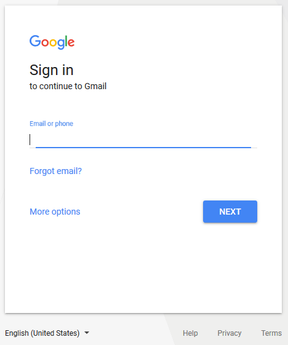
AIM was an instant messaging and presence computer program created by AOL, which used the proprietary OSCAR instant messaging protocol and the TOC protocol to allow registered users to communicate in real time.

Electronic mail is a method of transmitting and receiving messages using electronic devices. It was conceived in the late–20th century as the digital version of, or counterpart to, mail. Email is a ubiquitous and very widely used communication medium; in current use, an email address is often treated as a basic and necessary part of many processes in business, commerce, government, education, entertainment, and other spheres of daily life in most countries.
ICQ New is a cross-platform instant messaging (IM) and VoIP client. The name ICQ derives from the English phrase "I Seek You". Originally developed by the Israeli company Mirabilis in 1996, the client was bought by AOL in 1998, and then by Mail.Ru Group in 2010.
The Session Initiation Protocol (SIP) is a signaling protocol used for initiating, maintaining, and terminating communication sessions that include voice, video and messaging applications. SIP is used in Internet telephony, in private IP telephone systems, as well as mobile phone calling over LTE (VoLTE).

Instant messaging (IM) technology is a type of online chat allowing real-time text transmission over the Internet or another computer network. Messages are typically transmitted between two or more parties, when each user inputs text and triggers a transmission to the recipient(s), who are all connected on a common network. It differs from email in that conversations over instant messaging happen in real-time. Most modern IM applications use push technology and also add other features such as emojis, file transfer, chatbots, voice over IP, or video chat capabilities.
Messenger was an instant messaging and presence system developed by Microsoft in 1999 for use with its MSN Messenger software. It was used by instant messaging clients including Windows 8, Windows Live Messenger, Microsoft Messenger for Mac, Outlook.com and Xbox Live. Third-party clients also connected to the service. It communicated using the Microsoft Notification Protocol, a proprietary instant messaging protocol. The service allowed anyone with a Microsoft account to sign in and communicate in real time with other people who were signed in as well.

Pidgin is a free and open-source multi-platform instant messaging client, based on a library named libpurple that has support for many instant messaging protocols, allowing the user to simultaneously log in to various services from a single application, with a single interface for both popular and obsolete protocols, thus avoiding the hassle of having to deal with a new software for each device and protocol.

Yahoo! Messenger was an advertisement-supported instant messaging client and associated protocol provided by Yahoo!. Yahoo! Messenger was provided free of charge and could be downloaded and used with a generic "Yahoo ID" which also allowed access to other Yahoo! services, such as Yahoo! Mail. The service also offered VoIP, file transfers, webcam hosting, a text messaging service, and chat rooms in various categories.

iChat is a discontinued instant messaging software application developed by Apple Inc. for use on its Mac OS X operating system. It supported instant text messaging over XMPP/Jingle or OSCAR (AIM) protocol, audio and video calling, and screen-sharing capabilities. It also allowed for local network discussion with users discovered through Bonjour protocols.
In computer and telecommunications networks, presence information is a status indicator that conveys ability and willingness of a potential communication partner—for example a user—to communicate. A user's client provides presence information via a network connection to a presence service, which is stored in what constitutes his personal availability record and can be made available for distribution to other users to convey their availability for communication. Presence information has wide application in many communication services and is one of the innovations driving the popularity of instant messaging or recent implementations of voice over IP clients.
Tlen.pl was an adware licensed Polish instant messaging service. It was fully compatible with the main Polish Gadu-Gadu instant messenger. It was launched in 2001 and discontinued in May 2016.

Google Talk was an instant messaging service that provided both text and voice communication. The instant messaging service was variously referred to colloquially as Gchat, Gtalk, or Gmessage among its users.
The following is a comparison of instant messaging protocols. It contains basic general information about the protocols.

Xfire was a proprietary freeware instant messaging service for gamers that also served as a game server browser with various other features. It was available for Microsoft Windows.
Microsoft Notification Protocol is an instant messaging protocol developed by Microsoft for use by the Microsoft Messenger service and the instant messaging clients that connect to it, such as Skype since 2014, and the earlier Windows Live Messenger, MSN Messenger, Windows Messenger, and Microsoft Messenger for Mac. Third-party clients such as Pidgin and Trillian can also communicate using the protocol. MSNP was first used in a publicly available product with the first release of MSN Messenger in 1999.
Live Communications Server 2005, codenamed Vienna, is the second version of a SIP based instant messaging and presence server after Live Communications Server 2003. LCS 2005 was first released in 2005, and was updated with new features with Service Pack 1 in 2006. LCS 2005 has been superseded by Microsoft Office Communications Server 2007.

MSN Messenger, later rebranded as Windows Live Messenger, was a cross-platform instant-messaging client developed by Microsoft. It connected to the now-discontinued Microsoft Messenger service and, in later versions, was compatible with Yahoo! Messenger and Facebook Messenger. The service was discontinued in 2013, replaced by Skype.

The Gmail interface makes Gmail unique amongst webmail systems for several reasons. Most evident to users are its search-oriented features and means of managing e-mail in a "conversation view" that is similar to an Internet forum.

Google Wave, later known as Apache Wave, is a discontinued software framework for real-time collaborative online editing. Originally developed by Google and announced on May 28, 2009, it was renamed to Apache Wave when the project was adopted by the Apache Software Foundation as an incubator project in 2010.

aMSN was a free Windows Live Messenger clone. aMSN attempted to emulate the look and feel of Windows Live Messenger, and supported many of its features. It had been downloaded approximately 40 million times as of January 2011, making it the 21st most downloaded project on SourceForge.










